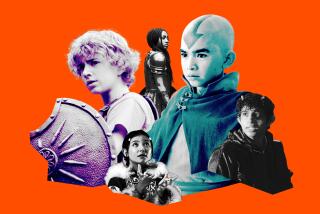‘The Lion King’: Is it animated or live-action? It’s complicated
In the run-up to this weekend’s release of the highly anticipated remake of “The Lion King,” the film has generally been referred to as a live-action reinterpretation of the 1994 animated classic, the latest in a string of such films Disney has released in recent years, including “Cinderella,” “Beauty and the Beast” and “Dumbo.” But if you think about it for more than two seconds, that can’t possibly be an accurate description, because — the last time we checked — lions, hyenas, meerkats and warthogs don’t actually talk. Or dance. Or burst into song.
So “The Lion King” should actually be categorized as an animated film, albeit one using cutting-edge digital tools in pursuit of photorealism instead of the original film’s stylized hand-drawn animation, right?
Well, that’s not exactly it either. Yes, “The Lion King” was made entirely using computer-generated imagery, all 1,600 shots of it. But at the same time, the movie’s creative team also used a range of live-action filmmaking tools and techniques — from lighting to camera movement to set dressing — that have been around for more than a century, as well as a few that are entirely new.
So ... it’s both. Or neither. Or something else altogether. Even director Jon Favreau isn’t sure what exactly to call it.
“There’s so much confusion as to what the medium is,” Favreau says of the film, which was developed through Disney’s live-action division rather than Walt Disney Animation Studios. “Is it a hybrid? Even that is misleading. ... The trick here was to make it feel like an entirely new medium. Even though we use animation techniques, we wanted it to appear live-action. And that required a lot of technical and technological innovation.”
On the most basic level, the film is indeed best described as animated, taking computer-animation tools that Favreau utilized on his 2016 remake of “The Jungle Book” — which, in turn, had built on what James Cameron had pioneered in “Avatar” — and extending them even further.
While “The Jungle Book” had one real, flesh-and-blood onscreen performer — Neel Sethi, who played Mowgli — surrounded by digitally created animals and environments, everything you see in “The Lion King” is the product of digital artists painting with ones and zeroes, down to the finest blade of grass on the African savanna. (Favreau did sneak one real, non-CGI shot into the film “just to see if anybody would be able to pick it up.”)
“ ‘The Jungle Book’ was almost like a first go-round, and after that I felt like I was ready to take out the security blanket of removing the one human element,” Favreau says. “Pulling the one kid out, we just jumped over to using similar techniques but now we were going to be completely animated and none of it was going to be live-action. ... Every single shot, every performance, is key-frame animated. There’s no motion capture. It’s not like we scanned an animal doing it. It’s artists hand-animating everything, just like ‘Bambi.’ ”
But it’s a little more complicated than that. In fact, the “Lion King” team deviated in critical ways from the typical CGI animation process, blending animation and live-action approaches in a unique and somewhat mind-bending way. All of the film’s environments and animals were rendered digitally, and then those low-resolution computer-generated elements were subsequently loaded into a kind of virtual-reality movie set, where Favreau and cinematographer Caleb Deschanel set about working out how to film them as though they were making a live-action movie.
“We built an entire VR volume that an entire camera crew could be in,” Favreau says. “We would pop on the headsets and we would all be there scouting this sort of video-game version of ‘The Lion King’ with pre-animated sequences and rendered environments. We would move around real dollies and those dollies and those wheels would be operating virtual cameras within VR. Everything was meant to emulate what the process would be like if we were filming this for real.”
Visiting that set vividly brought home the way the film blurred the boundaries between animation and live-action, Sean Bailey, Disney’s president of production, told The Times earlier this year.
“I think from a filmmaking perspective it’s a fascinating conversation and a fascinating debate to have, because it really is a hybridization of techniques,” Bailey said. “I remember commenting at one point to Caleb, ‘Well, the great news is you can stop the sun when you get the ideal lighting.’ And he said, ‘No, we don’t do that. We keep the sun moving just like we would on a normal day. We have to chase it. Because it’s a live-action movie.’ I said, ‘But it’s all digital assets.’ He said, ‘Yeah, but I’m covering it just as if I was there.’ ”
Ultimately, Favreau says, the film’s unique hybrid process was in service of creating an aesthetic that felt more like a live-action film than an animated one. “Traditional 2-D animation has different advantages,” says the director. “You can completely anthropomorphize characters. You can stylize the color palette and the settings and there is the wonderful emotional human touch to the way the characters’ performances are depicted. But our advantage is that we can show the beauty and the naturalism of the world using these amazing technological breakthroughs.”
In marketing the film, Disney has carefully avoided defining “The Lion King” as either animated or live-action, instead describing it as “photoreal.” For the purposes of the Academy Awards, however, the studio is expected to position the film as live-action rather than animated, as it did with “The Jungle Book,” which ultimately won an Oscar for visual effects. As it is, the studio already has two likely Oscar contenders for animated feature in “Toy Story 4” and the upcoming “Frozen 2.”
However one categorizes the film, Favreau is proud that the process of making “The Lion King” brought together both filmmaking’s past and its future. Call it the circle of life, Hollywood style.
“Often new technologies disrupt the whole industry, but in this case we really went out of our way to have a full crew of people who came up through traditional filmmaking, from grips to set dressers to [assistant directors],” he says. “Just because there’s a new tool and a new technology doesn’t mean you can’t take advantage of the traditions and skills that people have learned over a lifetime. To have Caleb Deschanel sit down and explain how lighting works to a kid who writes code is, to me, a huge part of keeping our tradition alive.”
More to Read
Only good movies
Get the Indie Focus newsletter, Mark Olsen's weekly guide to the world of cinema.
You may occasionally receive promotional content from the Los Angeles Times.











